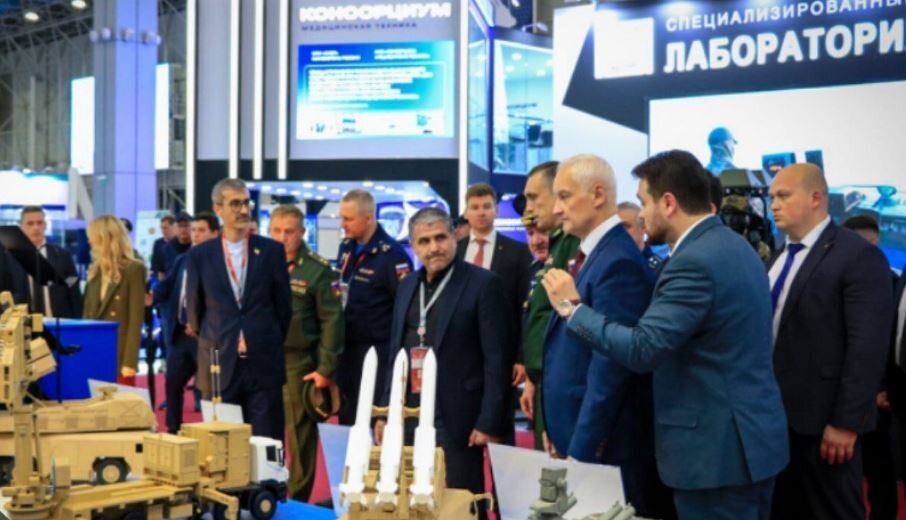Russian defense minister highlights Iran’s growing presence at ‘Army 2024’

TEHRAN– The "Army 2024" International Military-Technical Forum, taking place near Moscow, has attracted high-level attention from global defense officials, including Russian Defense Minister Andrei Belousov.
Among the numerous international exhibits, the Iranian pavilion emerged as a focal point during the event, showcasing Tehran’s latest advancements in military technology.
The Russian Ministry of Defense, in a statement, highlighted a range of showcased products, including FPV drones, electronic warfare devices, remotely operated platforms for small arms, and anti-tank guided systems.
Minister Belousov emphasized Russia's interest in the military capabilities of its global partners.
In addition to Iran, Belousov toured the displays of other key participants, including China, Belarus, and several other nations, highlighting the diversity of military innovations on display at the forum.
The Iranian exhibit was particularly notable for its introduction of the domestically-produced "Mohajer-10" drone. This advanced unmanned aerial vehicle (UAV) quickly became a centerpiece of the forum, drawing substantial attention from military officials and experts.
The Mohajer-10, which represents a significant technological leap from its predecessors, underscores Iran's growing expertise in UAV development and its increasing self-reliance in defense technology.
According to Iranian media reports, the drone has an operational range of 2,000 kilometers (1,240 miles) and can fly for up to 24 hours. Its payload can reach 300 kilograms (661 pounds), double the capacity of the Mohajer-6, the reports have added.
This year marks Iran's third consecutive participation in the "Army" forum, and the country has made a strong impression with a wide array of defense innovations.
The Iranian pavilion not only featured the Mohajer-10 drone but also a variety of other key military technologies. These included state-of-the-art radar systems, advanced air and naval defense platforms, ballistic missiles, and equipment from Iran's aerospace industry. Industrial and military-grade batteries also featured prominently in the exhibit, further demonstrating the breadth of Iran's defense capabilities.
The official opening of the Iranian pavilion was attended by a high-ranking military delegation led by Brigadier General Ali Shadmani, Deputy Coordinator of the Khatam al-Anbiya Central Headquarters.
He was joined by Kazem Jalali, the Iranian Ambassador to the Russian Federation, in representing Iran at this prestigious event. Brigadier General Shadmani participated in the forum's opening ceremony as the representative of Major General Mohammad Baqeri, responding to an invitation from the Russian minister of defense.
During his visit, Brigadier General Shadmani toured various sections of the Iranian pavilion, examining the technologies and innovations on display. His visit underscored the strong defense ties between Iran and Russia and highlighted Tehran’s ongoing efforts to showcase its military advancements on the international stage.
Spotlight on Iran’s missile capabilities
A key highlight of the Iranian exhibit was the display of Iran's export-oriented ballistic missile families. The Fateh ballistic missile series, including the Fateh-110C (export name BM-300) and the Fath missile (export name BM-120), were prominently featured, alongside the Zelzal missile series.
The Zelzal missiles, which have been upgraded by removing rotational thrusters and adding a guidance system, represent significant advancements in Iran's missile technology.
Also on display was the Arman missile system, a short-range system formerly known as Ababil, which utilizes two different guidance systems. According to official reports, the Arman ballistic missile defense system is capable of engaging six targets at distances ranging from 120 to 180 kilometers.
Although no major changes were announced in the specifications of these systems, visitors noted modifications in the vehicle used to transport and launch the Arman missiles.
In the cruise missile category, Iran showcased a variety of systems, including the sea-based anti-ship cruise missile Ghader (CM-200), its air-launched variant (CM-200A), and the Qadir (CM-300).
For the first time, the Paveh cruise missile was introduced, marking its debut at the forum and signaling Iran’s intent to market this new system internationally.
With high-profile visits from Russian defense officials and a strong display of military innovation, Iran’s participation in the forum underscores its growing role in the global defense landscape.
In recent years, Iranian military specialists and engineers have achieved notable advancements in producing a diverse array of domestically developed equipment, fostering self-reliance within the armed forces.
Officials from Iran affirm their commitment to enhancing the nation's military capabilities, emphasizing their defensive nature.
Iran unequivocally states that negotiations will not affect its defense capabilities. Ayatollah Seyyed Ali Khamenei, the Leader of Islamic Revolution, consistently emphasizes the importance of maintaining and enhancing Iran's defense capabilities.
Leave a Comment